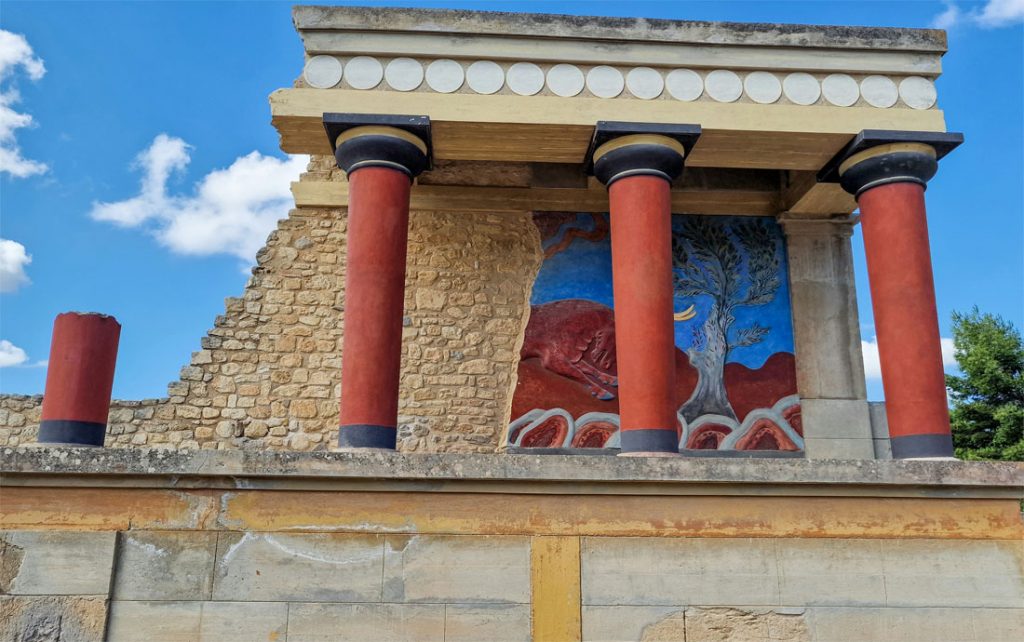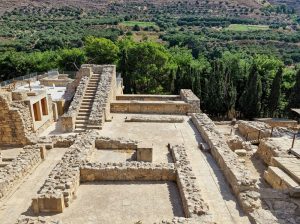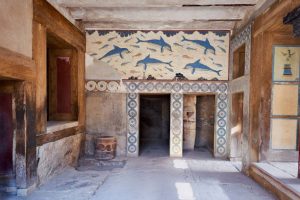Explore Knossos Palace: The Heart of Minoan Civilization in Crete
Knossos Palace stands as a testament to the ingenuity and artistry of the Minoan people. Its elaborate architecture, advanced engineering, and the rich cultural artifacts found within its walls offer a window into an ancient world that continues to fascinate historians, archaeologists, and visitors alike. Whether you’re drawn by the allure of ancient myths or the pursuit of historical knowledge, Knossos is a destination that promises to enrich and inspire.
Knossos is located just outside the modern city of Heraklion, making it easily accessible for visitors. The site is open to the public, with tours often available to provide detailed information about the history and significance of the ruins. The nearby Heraklion Archaeological Museum houses many of the artifacts found at Knossos and is an excellent complement to a visit to the palace, offering a deeper understanding of Minoan civilization.

Historical overview
The history of Knossos Palace in Crete dates back over 4,000 years ago. It was the center of the Minoan civilization and is believed to have been the legendary labyrinth where King Minos kept the Minotaur. The palace flourished during the Bronze Age, showcasing advanced architectural techniques and a complex layout.
 Over time, Knossos faced destruction multiple times due to natural disasters and invasions by foreign powers. Despite these challenges, it remained a symbol of power and innovation in ancient Greece. Excavations conducted by archaeologist Sir Arthur Evans in the early 20th century unearthed many secrets of this magnificent site.
Over time, Knossos faced destruction multiple times due to natural disasters and invasions by foreign powers. Despite these challenges, it remained a symbol of power and innovation in ancient Greece. Excavations conducted by archaeologist Sir Arthur Evans in the early 20th century unearthed many secrets of this magnificent site.
Today, visitors can explore the ruins of Knossos Palace and marvel at its grandeur. The intricate frescoes, grand throne room, and sophisticated plumbing system give us a glimpse into the sophisticated society that once thrived here. As we delve deeper into its history, we uncover layers of mystery and intrigue surrounding this iconic archaeological site.
The Myth of the Minotaur and King Minos
In the heart of the ancient Knossos Palace lies a tale shrouded in mystery and legend – the myth of the Minotaur and King Minos. According to Greek mythology, King Minos, ruler of Crete, commissioned Daedalus to build a labyrinth to contain his wife’s son, the Minotaur – a creature with the body of a man and head of a bull.
Legend has it that every year, seven young men and seven maidens from Athens were sacrificed as tribute to feed the monstrous Minotaur. Theseus, son of Aegeus, volunteered to slay the beast with help from Ariadne who gave him a ball of thread to find his way out after defeating the creature.
The intricate web of deceit, sacrifice, and heroism woven within this myth continues to captivate storytellers and historians alike. The legacy of King Minos’ reign intertwined with such fantastical narratives adds an air of mystique to Knossos Palace that echoes through time.
Architecture and Design of the Palace
Step into the world of Knossos Palace, where ancient architecture and design tell a story of grandeur and sophistication. The palace was strategically built with multiple levels, interconnected courtyards, and intricate passageways that showcase the Minoan civilization’s architectural prowess.
The structure boasts impressive features like colorful frescoes depicting mythical scenes, airy light wells providing natural illumination, and advanced plumbing systems for water management. The use of columns in varying shapes and sizes throughout the palace adds depth and character to its overall layout.
One cannot help but marvel at the attention to detail in every corner of Knossos – from the grand throne room adorned with alabaster gypsum benches to the labyrinthine layout that intrigues visitors with its complexity. The architectural ingenuity displayed at Knossos Palace stands as a testament to the creativity and innovation of its builders.
Important Rooms and Features of the Palace
As you wander through the ancient ruins of Knossos Palace in Crete, you’ll come across a myriad of important rooms and features that provide insight into the Minoan civilization. The Throne Room is an impressive space adorned with frescoes depicting bull leaping, showcasing the significance of this ritual to the culture.
The Grand Staircase is a masterpiece of engineering, displaying advanced architectural techniques for its time. It served as a central hub connecting different levels of the palace, symbolizing power and authority. Venturing into the Queen’s Megaron reveals intricate decorations and symbols believed to represent fertility and prosperity. This room offers a glimpse into the royal lifestyle and religious practices of the era.
Venturing into the Queen’s Megaron reveals intricate decorations and symbols believed to represent fertility and prosperity. This room offers a glimpse into the royal lifestyle and religious practices of the era.
Don’t miss the storage magazines where vast quantities of grain were once stored, emphasizing agriculture’s importance to sustaining the palace inhabitants. These rooms underscore how essential resources were managed within this complex society.
Exploring these significant spaces at Knossos Palace allows us to unravel mysteries from antiquity while marveling at their ingenuity and creativity.
Excavations and Restorations of Knossos
Excavations at Knossos Palace have unveiled a treasure trove of ancient history, shedding light on the Minoan civilization. Archaeologists have painstakingly unearthed artifacts and architectural remains that offer insights into the daily lives of its inhabitants. The restoration efforts aimed to preserve and showcase the palace’s grandeur, allowing visitors to envision its former glory.
Over the years, various experts have worked tirelessly to piece together the fragmented remnants of this majestic site. Through meticulous research and reconstruction, they have brought back to life parts of Knossos that were once lost to time. The ongoing excavations continue to reveal new discoveries and push the boundaries of our understanding of this remarkable archaeological wonder.
Visitors can now walk through corridors and chambers that were once buried beneath layers of earth, gaining a firsthand experience of Minoan craftsmanship and ingenuity in design. The excavations and restorations at Knossos Palace serve as a testament to human curiosity and determination in unraveling the mysteries of our past – each stone unearthed is a step closer towards unlocking ancient secrets buried for centuries.
Visiting Knossos: Tips and Recommendations
Are you planning a visit to the ancient Knossos Palace in Crete? Here are some tips and recommendations to make the most of your experience.
It’s advisable to arrive early in the day to avoid large crowds and fully appreciate the historical significance of this archaeological site. The weather can get hot during peak hours, so remember to bring sunscreen, water, and comfortable shoes for exploring.
While touring Knossos, consider hiring a guide or using an audio tour to gain insight into the palace’s rich history and mythology. This will enhance your understanding of the intricate architecture and design elements that have survived through millennia.
Don’t forget your camera! The vibrant frescoes, grand columns, and labyrinthine layout offer plenty of photo opportunities. Be respectful of the site by not touching any ancient artifacts or structures; preservation is key for future generations to enjoy this remarkable piece of history.
In conclusion – enjoy every moment at Knossos Palace and soak in its unique blend of myth, history, and architectural marvels as you wander through its ancient corridors.
Controversies Surrounding Knossos Palace
The Knossos Palace in Crete has long been a subject of debate and controversy among historians and archaeologists. One of the major controversies surrounding the palace is the extent to which Sir Arthur Evans, the British archaeologist who excavated and restored Knossos in the early 20th century, may have overinterpreted or even fabricated certain aspects of its design.
Critics argue that Evans took significant liberties in reconstructing parts of the palace, leading to accusations of historical inaccuracies and misrepresentations. Some believe that his restoration work may have distorted our understanding of Minoan civilization.
Additionally, there is ongoing controversy surrounding whether Knossos was actually a peaceful ceremonial center as Evans portrayed it or if it served more military or administrative functions. Some experts question whether the elaborate frescoes and intricate architecture truly reflected everyday life at Knossos or if they were exaggerated for dramatic effect.
Despite these controversies, Knossos remains an iconic site that continues to captivate visitors with its rich history and mysterious allure.
Impact and Legacy of Knossos on Modern Society
Knossos Palace in Crete continues to captivate people from all over the world with its rich history, mythical allure, and impressive architecture. Its impact on modern society is profound, as it has influenced art, literature, and even urban planning.
The legacy of Knossos extends beyond its physical remains; it serves as a reminder of the sophistication and creativity of ancient civilizations. The myth of the Minotaur and King Minos adds an air of mystery to this archaeological site, drawing in visitors who are eager to explore its labyrinthine corridors.
As excavations continue and more discoveries are made at Knossos Palace, our understanding of Minoan culture deepens. The preservation efforts aimed at restoring this magnificent structure ensure that future generations will have the opportunity to marvel at its beauty and significance.
Whether you’re a history enthusiast or simply curious about ancient civilizations, a visit to Knossos Palace is sure to leave a lasting impression. Immerse yourself in the wonders of antiquity and experience firsthand the magic that surrounds this legendary palace in Crete.
How to get there from Heraclion
Getting to Knossos Palace from Heraklion, the capital city of Crete, is quite straightforward, thanks to its proximity to the city. Located just about 5 kilometers (around 3 miles) southeast of Heraklion’s city center, Knossos Palace is accessible by car, bus, taxi, or even bicycle for those who prefer a more active mode of transport. Here’s how you can reach the archaeological site:
By Bus
- Public Buses: The local bus service is the most economical and convenient way to get to Knossos Palace from Heraklion. Buses to Knossos depart regularly from the Heraklion bus station, located near the city center.
- Bus Line: Look for buses marked with “Knossos” or ask for the bus going to the Knossos archaeological site. The ride takes about 20-30 minutes, depending on traffic.
- Tickets: Tickets can be purchased directly from the bus driver or at the bus station. It’s advisable to check the latest timetable and ticket prices as they can vary.
By Car
- Driving Directions: If you’re driving from Heraklion to Knossos, you can take Leof. Knosou, which is the main road leading directly to the site. The journey is short, making it a convenient option if you’re renting a car or traveling with a group.
- Parking: There is parking available near the entrance to the archaeological site, but it can get crowded during peak tourist season.
By Taxi
- Taxi Services: Taxis are readily available in Heraklion and offer a quick and comfortable way to reach Knossos. You can hail a taxi on the street, book one through your hotel, or use a taxi app.
- Fare Estimate: Make sure to ask for an estimated fare before starting your journey. Fares from Heraklion to Knossos are reasonable due to the short distance.
By Bicycle
- Cycling: For those who enjoy biking, cycling to Knossos is a viable option. The route is not very long, but it’s important to be cautious, as roads can be busy and may not always have dedicated bike lanes.
Tips for Visiting Knossos
- Best Time to Visit: Try to arrive early in the morning or late in the afternoon to avoid the crowds and the heat, especially during the summer months.
- Tickets: You can purchase tickets at the site. During peak season, consider buying a combined ticket from the Heraklion Archaeological Museum to skip the line.
- Guided Tours: Consider joining a guided tour to gain deeper insights into the history and significance of the ruins. Tours are available in various languages.
- Protection from the Sun: The site offers little shade, so it’s advisable to wear a hat, use sunscreen, and carry water.
Visiting Knossos Palace from Heraklion is a must-do activity for anyone interested in history, archaeology, or mythology. The convenience of getting there adds to the appeal, making it a straightforward addition to any travel itinerary on Crete.
